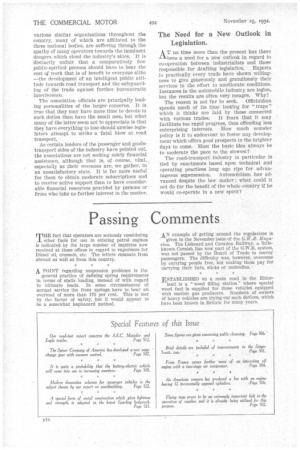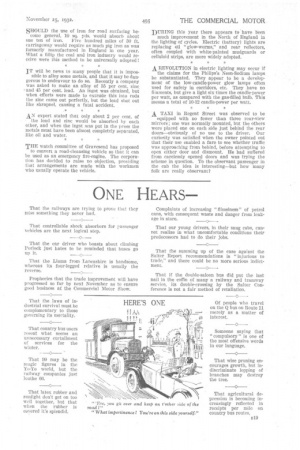Passing Comments
Page 36

Page 37

If you've noticed an error in this article please click here to report it so we can fix it.
TH1 fact that operators are seriously considering other -fuels for use in existing petrol engines Is indicated by the large number of inquiries now received at these offices in regard to vaporisers for Diesel oil, creosote, etc. The letters emanate from abroad as well as from this country.
A POINT regarding suspension problems is the general practice of defining spring requirements in terms of static loading, instead of with regard to ultimate loads. In some circumstances of normal service the front springs have to bear an overload of more than 170 per cent. This is met by the factor of safety, but it would appear to be a somewhat haphazard method. AN example of getting around the regulations is given in the November issue of the G.W.E. Magazine. The Liskeard and Caradon Railway, a littleknown Cornish line now part of the G.W.R. system, was not passed by the Board of Trade to convey -passengers. The difficulty was, however, overcome by carrying people free, but making them pay for carrying their hats, sticks or umbrellas.
ESTABLISHED on a main road in the Rhine
land is a "wood filling station" where special wood fuel is supplied for those vehicles equipped with suction gas producers. Numbers of owners of heavy vehicles are trying, out such devices, which have been known in Britain for many years. SHOULD the use of iron for road surfacing be come general, 10 sq. yds. would absorb about one ton of iron. -Five hundred miles of 30 ft. carriageway would require as much pig iron as was formerly manufactured in England in one year. What a fillip the coal and iron industry would receive were this method to be universally adopted!
IT will be news to many people that it is impos sible to alloy some metals, and that it may be dangerous to endeavour to do so. Recently a company was asked to make an alloy of 55 per cent, zinc. and 45 per cent. lead. An ingot was obtained, but when efforts were made to extrude this into rods the zinc came out perfectly, but the lead shot out like shrapnel, causing a fatal accident.
AN expert stated that only about 2 per cent. of the lead and zinc would be absorbed by each other, and when the ingot was put in the press the metals must have been almost completely separated, like oil and water.
THE watch committee of Gravesend has proposed to convert a road-cleansing vehicle so that it can be used as an emergency fire-engine. The corporation has decided to raise no objection, providing that arrangements are made with the workmen who usually operate the vehicle. DURING this year there appears to have been much improvement in the North of England in the lighting of cycles. Electric (battery) lights are replacing oil "glow-worms," and rear reflectors, often coupled with white-painted mudguards or celluloid strips, are more widely adopted.
A_ REVOLUTION in electric lighting may occur if the claims for the Philips's Neon-Sodium lamps be substantiated. They appear to be a development of the low-candle-power glow lamps often used for safety in corridors, etc. They have no filaments, but give a light six times the candle-power per watt, as compared with the gas-filled bulb. This means a total of 10-12 candle-power per watt.
A TAXI in Regent Street was observed to be equipped with no fewer than three rear-view mirrors; one was normally mounted, but the others were placed one on each side just behind the rear doors—obviously of no use to the driver. Our curiosity was satisfied when the owner pointed out that their use enabled a fare to see whether traffic was approaching from behind, before attempting to open either door and dismount. He had suffered from carelessly opened doors and was trying the scheme in question. To the observant passenger in the cab the idea is interesting—but how many folk are really observant?




































































































